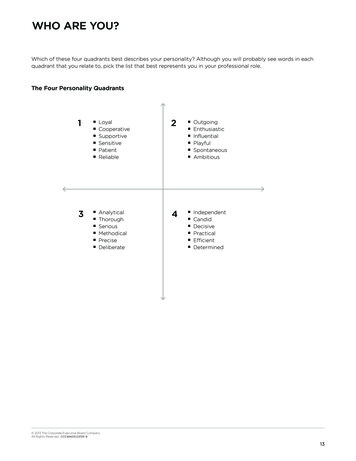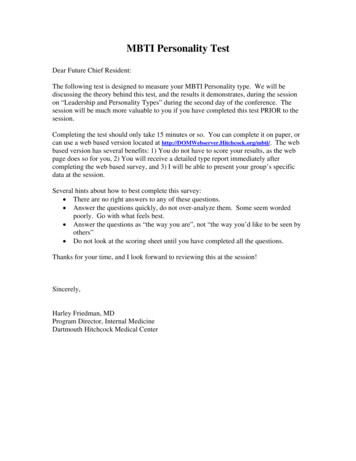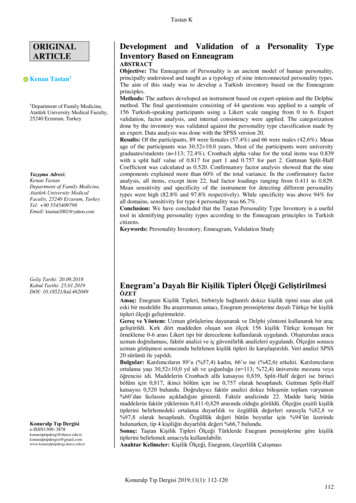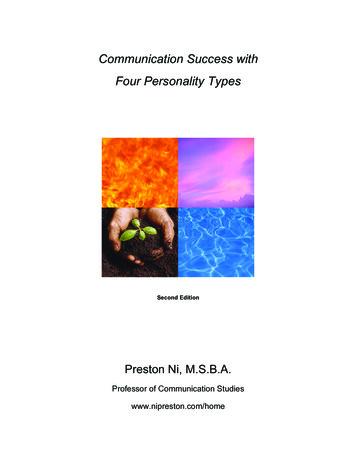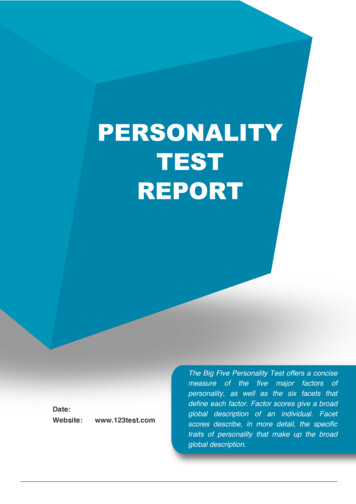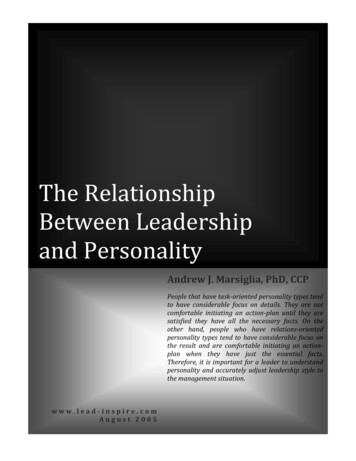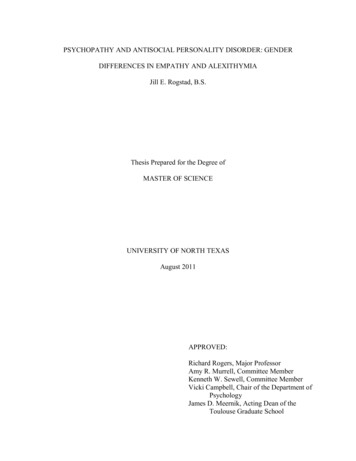
Transcription
The History of PersonalityTheory and Assessment
Table of ContentsSummary. 3Hippocrates through the Middle Ages.3Eighteenth Century Medicine.3Nineteenth Century. 3Twentieth Century. 3Missing the Mark . 5History of the Color Code.5Motive: The Key to Self-awareness.5Driving Core Motive. 5Needs and Wants. 6Instincts/Preferences. 6Personality Filters. 6Values and Behavior. 7Character. 8Back to Your Roots. 8Importance of Knowing an Individual’s Driving Core Motive.8Core Motive and Natural Talents.9Summary. 9The History of Personality Theory and Assessment 2
SummarySince ancient times, humans have sought to explain behavior by categorizingpersonalities into distinct types. Personality assessments have been developed over thepast several centuries to describe aspects of a person that remain stable throughout alifetime: the individual’s character pattern of behavior, thoughts, and feelings.Personality assessments have been used to sort, classify, and categorize people.References to personality assessments have even made their way into books and moviessuch as Harry Potter, who was placed into the Gryffindor House at the HogwartsSchool by a “sorting hat” that could gauge the temperament of each student.Hippocrates through the Middle AgesHippocrates recorded the first known personality model, postulating that one’s personais based upon four separate temperaments. Another Greek physician, Galen, extendedHippocrates’ theory by applying a body fluid to each temperament: blood, mucus, blackbile and yellow bile, respectively. Different diseases and behaviors had roots in the fourhumors and the fluid that was dominant was said to be the person’s “humor.”The four humors theory was to become a prevalent medical theory for over a millenniumafter Galen’s death. The theory experienced widespread popularity throughout theMiddle Ages.Four Humors:BloodMucusBlack BileYellow BileEighteenth Century MedicineBy the 18th century, medicine was advancing rapidly. The discoveries of the functionsof the circulatory, respiratory and digestive systems served to discount the four humorstheory as a realistic practice of medicine. However, it remained important in terms ofdesignating personality.Nineteenth CenturyLate 19th/early 20th century physiologist Wilhelm Wundt expounded on the fourhumors theory in 1879 and he is noted to be the first person to make clear distinctionbetween human body and personality. Wundt realized that temperaments could not belimited to the body fluids. He theorized that four temperaments—sanguine, phlegm,cholera and melancholy—were actually four dimensions of the human personalityand no individual was completely of one temperament; rather that everyone typicallyhas varying proportions of two or more. He believed that all four temperaments werebasic dimensions of the human personality and that the temperaments fell along axesof “changeability” and “emotionality”.Four eth CenturyThe rapid growth of the field of psychology beginning in the early 20th centuryled to increased interest regarding individual personality. The following representphilosophers originating theories at the turn of the century:Sigmund Freud posited a structural model of the mind in which id, ego, and superego(the three components of the human mind) interacted and wrestled with each otherfor dominance. The result of this constant struggle is the whole of each human’sbehavior.The History of Personality Theory and Assessment 3
Eduard Spranger, a German philosopher, theorized four attitudes towards ethical values.He named those attitudes as artistic, religious, theoretic and economic.Henry C. Link wrote a book Employment Psychology. He writes that ideal personalitytesting method can be a big machine that received data on one end and sorts the suitablecandidates for the specific jobs on the other. The German philosopher presented atheory of four character styles. He thought that people can be hypomanic, depressive,hyperesthetic or anesthetic depending upon their character styles.Erich Fromm, another German philosopher wrote that there are four human orientation;exploitative, hoarding, receptive and marketing.Carl Jung, a younger colleague of Freud’s, categorized mental functioning again intofour principle categories: sensing, intuition, thinking, and feeling. Jung believed thatalthough we could develop all functions, his experience working with clients was thatsustainable mental health was the result of using and leading with our natural “leadfunction.”According to Jung’s suggestion that there are four fundamental ways we deal with theworld: sensing, intuition, thinking, and feeling, we each have a preferred way—usuallythe way we are most comfortable with and best at doing.Myers-Briggs was developed by Katharine Briggs and her daughter Isabel Briggs Myers.They thought that knowing personality preferences would help women entering theworkforce for the first time during WWII choose jobs they were most comfortable andeffective doing. The MBTI test takes Jung’s theory and asks questions that do not putpeople in categories of good or bad. Instead, the outcome from the test encouragespeople to become more self-aware.Abraham Maslow believed humans are driven to achieve their maximum potential andwill always do so unless obstacles are placed in our way. Maslow developed a pyramidcalled the Hierarchy of Needs, that explains his theory best. Humans have specificneeds that must be met. If lower level needs go unmet, we cannot move up to meet thenext level needs. At the lower level we must focus on basic needs such as food, sleep,and safety. If we don’t get food or if we go without sleep, it is impossible to focuson the higher level needs such as self-esteem or to reach thelevel of self-actualization.John B. Watson in responding to theories popular in the early20th century, asserted that all things done by organisms,including those by humans—like acting, thinking andfeeling—should be regarded as behaviors. Theorist believethat all behaviors are observational whether the actions arepublicly displayed or of a private nature, such as thinkingand feeling.The belief in nurture over nature is a secondfundamental characteristic of behaviorists. They believe thatthe mind begins as a blank box, so the environment has asingular influence over one’s behavior. According to Watson,morality,creativity,spontaneity,problem solving,lack of prejudice,acceptance of factsself-esteem, confidence,achievement, respect ofothers, respected by othersfriendship, family, sexual intimacysecurity of body, of employment, of resourcesof morality, of the family, of health, of propertybreathing, food, water, sex, sleep, homostasis, excretionSelf alMaslow’s Hierarchy of NeedsThe History of Personality Theory and Assessment 4
the environment in which a child is raised determines intelligence, temperament, andother personality characteristics of that child; genetics are unimportant. The followingis a famous quote by Watson:“Give me a dozen healthy infants, well-formed, and my own specified world to bring them up inand I’ll guarantee to take any one at random and train him to become any type of specialist I mightselect—doctor, lawyer, artist, merchant-chief, and, yes, even beggar-man and thief, regardless of histalents, penchants, tendencies, abilities, vocations, and race of his ancestors.”Missing the MarkThe various models previouslydescribed are all behavior-based andthus, they skip the critical step: motive.They go as deep as the needs andwants of an individual influencingbehavior, but they fail to grasp whatcreates those needs and wants. Dr.Taylor Hartman maintains behavior isonly an outward expression of whatis truly happening on the inside of aperson. Behavior-based models simplyidentify what people do, but we needto go much deeper; we need to knowwhy they do it.History of the Color CodeThe theory of a driving core motive (DCM) to answer the questions of why wasoriginated by Dr. Hartman. With a Ph.D. in Human Behavior and Leadership, hedocumented his ideas on motive in a book, The Color Code.Motive: The Key to Self-awarenessWhile self-awareness is the key to building emotional intelligence, motive is the keyto building self-awareness. The Color Code is based on this premise. Understandably,many people don’t comprehend the difference between behavior and motive. Afterall, behavior has been the focus of academia for nearly 50 years. The problem withbehavior, however, is that it limits us to observing merely what people do. Motive, onthe other hand, enables us to understand why people do what they do, and allows us tocreate lasting, effective change. Behavior is infinitely limited, because it is easily maskedor imitated and, like the tip of an iceberg, it shows only a portion of the big picture.Motive, however, is an understanding of why people behave the way they do, whichgives a big-picture view of the truth behind the behavior.Driving Core MotiveLet’s start with driving core motive (DCM). This is the critical piece of who you arethat sets The Color Code apart from other psychological assessment theories andThe History of Personality Theory and Assessment 5
tools. As you can see from the illustration, DCM provides theimmutable foundation for who you are. DCM is not learnedor developed. It is innate and will always fundamentallydrive our individual choices. Irrespective of our behavior invarious situations or at different times in our lives, our DCMscame with us at birth and will never change. DCM inducesa person to act in a certain way and provides an inborn setof preferences. DCM is the root of what we think and do. Itis the driving force behind our personalities. DCM is to ourpersonalities what breathing is to the human body. You don’thave to think about it, it is subconscious, automatic.The Color Code, indentifies DCM by using four colors: Reds,power; Blues, intimacy; Whites, peace; and Yellows, sBehaviorFiltersFiltersInstincts/PreferencesNeeds & WantsInnateInnate(Nature)(Nature)Driving Core MotiveEach DCM drives a pattern of predictable strengths andlimitations. Typically, an individual will have the most strengths and limitations commonto his/her DCM with some combination of strengths and/or limitations from otherDCMs.The most important thing you can do is to understand the significance of driving coremotive. If you do, it will favorably change your entire world of relationships forever.Needs and WantsEach of the four driving core motives influence a set of predictable needs and wants.We’re not talking about basic needs such as food, shelter, etc. We are speaking of thenecessity to fulfill psychological needs and wants, such as needing respect or wantingto look good socially. These are the strongest tendencies for each DCM. Rememberthat not every need and want will be present in every person with the correspondingDCM. For example, you could be a Blue who needs to be understanding but does notparticularly need acceptance. On the other hand, an individual with one DCM can havea need or want from another DCM. To illustrate, a Yellow could want to be productive,which is a want most naturally associated with Reds.Like your DCM, your individual set of needs and wants came with you at birth. Unlikeyour DCM, needs and wants can change over time. The change at first requires aconscious, unnatural effort, but can become permanent and subconscious over time.Instincts/PreferencesWe are all born with natural instincts and preferences. Think of how differently twoinfants might react when approached by an unfamiliar person. Although you have thesame DCM as many other people, your instincts and preferences help set you apartand make you unique. Combining your DCM, instincts and preferences, and needs andwants creates your innate personality, which plays a vital role in what path you chooseto take in your life. Your personality determines whether you are easily depressed,casual, critical, careful, or carefree. It determines whether you are passive or assertive.Your personality is more than just an “attitude.” It reflects your inborn preferences,The History of Personality Theory and Assessment 6
actions, and reactions in life. This all-encompassing personality directs you to respondemotionally or rationally to every life experience. Personality is the innate style ofattitudes and behaviors that comes with you at birth and is based on your DCM.Personality FiltersThough your DCM is the most critical factor in determining how you will face life, itis clearly influenced by a myriad of other significant variables that create your personalhistory.Consider a man who was born with the White DCM of Peace, but was raised by afamily that promoted a Red lifestyle. Responsibility, a strong work ethic, and an overlyaggressive mentality were all values that were promoted as he grew up. Let’s say thatWhite man was taught that it was not okay for him to be kind, tolerant, and accepting(his natural White strengths) because those qualities make people weak. Obviously thisman will have a harder time discerning his DCM of Peace as an adult, because he wastaught that it was unacceptable. He sees himself as a Red, because he was taught thatRed is the only way to be.The way this individual’s parents chose to raise him imposed a Red “filter” on him thatwill affect the way he lives his life, his happiness, and his ability to grow. No doubt, helearned some positive skills. Unfortunately, however, he was taught to not value whohe truly is. That belief will ultimately become a major source of frustration in his lifebecause he will not be acting true to his driving core motive of Peace, and therefore,it will be difficult for him to feel fulfilled.Hundreds of filters just like this exist in our society. Men are expected to be one wayand women another. Religion can be a filter, intelligence can be a filter. Introversionand extroversion can be filters.It is important to remember that no filter can actually cause us to change our coremotives. A Yellow woman is still motivated by Fun, even if she may have been taughtthat Blue is the only way women should be—even if she believes it! Driving coremotive always runs true. Sometimes we have to strain to see past the filters that “color”our perception of who we are, because they can be strong, but this is what developingself-awareness is all about.Values and BehaviorLike filters, our values and behaviors are elements of our personality that are learnedthrough various life experiences.Let’s start with values. We begin learning values from a very young age. Our parents,friends, the education system, religion, our culture, the government, and many otherindividuals and institutions will emphasize certain values over others. Values are notnecessarily always positive, like honesty or hard work. For example, racism can beclassified as a value, because it means people value one race over another. Values mayor may not fit with what our DCMs lead us to value. Therefore, they may feel eithernatural or unnatural. However, even that which is unnatural can eventually be adoptedinto our value system if we allow it to be.The History of Personality Theory and Assessment 7
Behavior is a way in which an individual acts in response to a particular situation orstimulus. People learn to behave certain ways as they progress through life. Behavior canbe taught, mimicked, and/or modified. It begins as a conscious, or learned, response.Over time, though, if that behavior is repeated often enough it can become part of ourunconscious personality. Think of a small child who realizes that throwing a fit getshim what he wants. He might make the conscious decision to throw a fit so often thateventually it becomes his natural reaction to not getting his way.Personality development over time, which comes about by adding unconsciousbehaviors to an individual’s persona can be either positive or negative.CharacterCharacter, at the top of the pyramid, represents the ideal level of personal development.It consists of learned, unconscious behaviors that are typical traits of colors outsideof the individual’s DCM.For example, if a Yellow becomes a good-listener, which is typically a White trait,that would be considered character development. If the same Yellow wasn’t born asociable person, but learns to become one, that would certainly be considered healthypersonality development, but definitely not character development, because beingsociable is a trait natural to Yellows.Again, developing character occurs when we successfully develop the strengths ofcolors outside our core.Normally, your innate personality doesn’t naturally venture out to experience orunderstand other DCMs. Most of us assume that others see things (or at least that theyshould see things) exactly the same way we do. While our personalities are generallyquite accepting of themselves—us—they are much less flexible with or inviting ofothers. You must develop your core strengths and challenge your core limitations inorder to progress and live more happily and healthfully. Then, look to develop thestrengths of the other colors to become more charactered.Back to Your RootsNow that you understand the difference between motive, personality and behavior,you probably see how pointless it is to try and simply evaluate and change behavior.Dealing directly with behavior is to just scratch the surface. We must go deeper. Sooften, as we look to change or improve relationships, we naturally look at observablebehaviors and attack the concerns cosmetically.Importance of Knowing an Individual’s Driving Core MotiveWhen a child is born, the first thing we look for is ten fingers and ten toes. Far morecritical to their life experience, however, is their innate personality. Personality affectsevery aspect of our entire lives, especially relationships, far more than physical featuresdo. It is critical for you to know yourself so you can align congruently with your naturalpreferences. It gives you the creative edge in developing emotional intelligence and itsfrequent companion, success in life. Furthermore, if you don’t know yourself—yourThe History of Personality Theory and Assessment 8
DCM, your strengths and limitations—how can you expect others to relate effectivelyto you or you to them?Looking to another’s DCM rather than behavior alone gives you an accurate startingplace to understand them. As stated, behavior often does not reflect what lies beneaththe surface. For example, everyone gets angry. Anger is a behavior. But it’s the why thatmatters. To understand fully why a person is angry, you need to get back to their DCMand their needs and wants. This review will inform you as to why they are angry andwill help you more accurately determine how to defuse the anger.Some people find it unsettling that personality is categorized into only four groups inthe Color Code. What needs to be understood is that the Color Code doesn’t carelesslylump people into four categories. It only identifies what motivates them. In all theyears of Dr. Hartman’s research into the subject, he has never come across someonewho was motivated by something other than power, intimacy, peace, or fun. Think ofit this way: the human face, which has only a small number of variables (eyes, nose,chin, ears, hair, etc.), has never produced exactly the same look. The same is trueof personality. While core personalities are “limited” to only four core motives (orcolors), no two people are exactly the same. This concept will become evident as youwork through this program.Core Motive and Natural TalentsAny color can do any job. However, there are certain fields that enhance each color’sstrengths and take advantage of natural talents. Reds excel in leadership positions,Blues do well in areas that involve working with people and details, Whites shine inroles that allow them to use their gift of logical clarity in an independent setting, andYellows feel very comfortable when they can tap into their social skills and enjoy ahealthy amount of freedom. The Color Code will make it easier for you to know thenatural talents of individuals by knowing their core color.SummaryAs this paper illustrates, personality assessments have proven to be a point of interestfor centuries. Today the personality assessment industry is a 400 million industry. Astudy by the American Management Association reveals that 39 percent of companiessurveyed use personality assessment as part of their hiring process. More people areusing personality assessments to evaluate their business partners, their dates and theirspouses. Salespeople are using personality models to better understand the needs oftheir customers and to gain a competitive edge in the closing of deals. College studentshave started to use personality assessments to evaluate their roommates. Lawyers arebeginning to use personality assessments for criminal behavior analysis, litigationprofiling, witness examination and jury selection.The History of Personality Theory and Assessment 9
the way we are most comfortable with and best at doing. Myers-Briggs was developed by Katharine Briggs and her daughter Isabel Briggs Myers. They thought that knowing personality preferences would help women entering the workforce for the first time during WWII choose jobs


